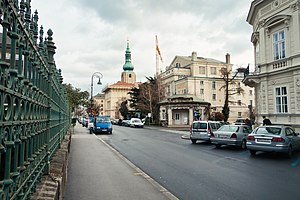Travel to Baden and experience the parks and a picturesque surrounding, of which the most frequented is the Helenental valley.
Spend some time at the casino Casino Baden, Baden.
Visit the town Square Holy Trinity Column and find accommodation near Holy Trinity Column, Baden
The composer Ludwig van Beethoven stayed a number of times in Baden, and many of his residences can still be seen today. House of Beethoven, Baden
Search for accommodation near the House of Art, Baden.
Visit the Municipal theatre, Baden
Roman baths, Baden offers bathing for both therapeutic and recreational purposes.
Visit Rosarium, Baden, in 2013 a big part of the Rosarium was redeveloped.
 Baden bei Wien
Baden bei WienBaden is a spa town in the Austrian state of Lower Austria and the capital of the Baden district. Located about 26 kilometres south of Vienna, frequently the name is given as Baden bei Wien (Baden near Vienna); this name, however, is not official, but can be used to distinguish it from other cities of the same name such as Baden-Baden or Baden, Switzerland. The municipality consists of the Katastralgemeinden Baden, Braiten Gamingerhof Leesdorf Mitterberg, Rauhenstein and Weikersdorf. Baden is situated at the mouth of the romantic Helenental, part of the Schwechat river valley within the Wienerwald mountain range, and used to be the principal summer resort of the wealthy inhabitants of Vienna, the neighbouring Austrian capital. It possesses a Kurhaus, fifteen bathing-establishments, a parish church in late Gothic style, and a town-hall, which contains archives. The warm baths, which gave name to the town, are thirteen in number, with a temperature of from 22°C (72°F) to 36°C (97°F), and contain, as chief ingredient, sulphate of lime. They rise for the most part at the foot of the Calvarienberg (1070 ft), which is composed of dolomitic limestone, and are mostly used for bathing purposes. Baden is surrounded by about 120 vineyards and has about 70 wine pubs (). The celebrity of Baden dates back to the days of the Romans, who knew it by the name of , and remains of their occupation still exist. The settlement was mentioned as Padun in a 869 deed and received town privileges in 1480. Although sacked at various times by Hungarians and Turks, it soon flourished again. Several members of the Austrian imperial family had made Baden their summer residence and had luxuriant villas build here, most notably Emperor Francis of Austria. After the town was ravaged by a blaze in 1812 it was extensively rebuilt in a Biedermeier style according to plans by architect Joseph Kornhäusel, it is therefore sometimes referred to as the Biedermeierstadt. In World War I Baden temporarily was the seat of the high command of the Austro-Hungarian Army. The opening of the casino in 1934 finally made the town the most important spa resort of Austria. After World War II Baden served as the headquarters of the Soviet forces within Allied-administered Austria until 1955. Jewish history The town offers several parks and a picturesque surrounding, of which the most frequented is the Helenental valley. Not far from Baden, the valley is crossed by a widespread aqueduct of the Vienna waterworks. At its entrance, on the right bank of the river, lie the ruins of the 12th-century castle of Rauheneck. On the left bank, just opposite, stands the ruined castle of Rauhenstein, dating also from the 12th century. About 4 m. up the valley is Mayerling, a hunting-lodge, where Crown Prince Rudolf of Austria and Baroness Mary Vetsera were found dead in 1889. Farther up is Alland, whence a road leads to the old and well-preserved Heiligenkreuz Abbey.





